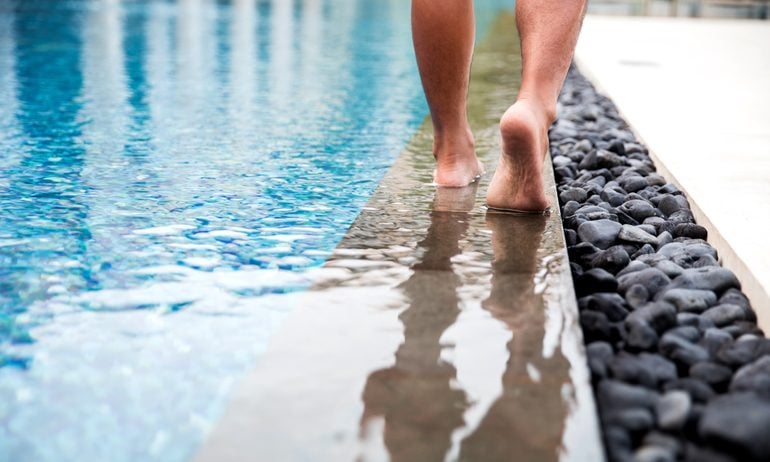How Much an Inground Pool Costs in 2025 and Ways to Save
Costs can vary dramatically depending on size, style and materials.

Some or all of the mortgage lenders featured on our site are advertising partners of NerdWallet, but this does not influence our evaluations, lender star ratings or the order in which lenders are listed on the page. Our opinions are our own. Here is a list of our partners.
An inground pool costs about $65,000 to install on average. Large pools, pools made of higher-quality materials (which can last longer) and pools with special design features cost more. Installation and materials cost $25,000 at the lowest end of the spectrum and more than $100,000 at the highest.
Understanding what kind of pool is feasible for your budget can help you tailor your construction planning. Before you start studying the blueprints, learn what’s behind inground pool costs and some strategies for financing your summer swims.
Inground pool installation costs
Here are a few considerations that can affect the price of your pool, with corresponding estimates.
Location
The cost of living in your city affects labor and material prices. Building an inground pool in a dense, high-cost metropolitan area is typically more expensive than in a suburban or rural area. Northern climates, where pools are less common, can also have higher installation costs than sunny southern states.
For example, the average pool costs between $52,000 and $79,000 to install in Vermont, compared to a range of $34,000 to $55,000 in Alabama, according to the project hiring platform Angi.
» MORE: How to pay for a pool in 2024
Size
Large, inground pools require more labor and materials than small ones. The same goes for deep vs. shallow pools. You can expect to spend about $50 to $125 per square foot.
Size | Cost |
|---|---|
10 x 20 ft. | $10,000-$25,000. |
14 x 28 ft. | $19,600-$49,000. |
16 x 32 ft. | $25,600-$64,000. |
20 x 40 ft. | $40,000-$100,000. |
Pool type
Vinyl-lined, fiberglass, concrete and gunite (a type of concrete) pools often have different installation costs. More expensive options tend to last the longest without needing to be replaced.
Material | Installation cost | Longevity |
|---|---|---|
Vinyl | $20,000-$40,000. | 10 years. |
Fiberglass | $20,000-$85,000. | 25 years. |
Concrete or gunite | $35,000-$120,000. | 50-100 years. |
Sources: HomeAdvisor, HomeGuide, Angi | ||
Shape and features
The shape of your pool will play a role in the installation price. For instance, a lagoon-style pool typically costs between $38,000 and $150,000, while you can expect a lap pool to cost between $40,000 and $95,000.
Special features, such as diving boards (often $300-$1,000, though some cost more), lighting ($450-$1,800) and heating ($500-$7,500, with electric heaters costing less and solar heaters or heat pumps costing more) can also add up.
Additional installation expenses
Permits: $100-$1,800. Like other permanent home additions, inground pools require a permit from the local building authority. You may also have to pay an inspector to locate potential sewer or utility lines before digging.
Deck: $3,000-$20,000. Inground pools must be surrounded by a sidewalk or deck. Costs can range widely, mostly due to different material costs. For example, pavers tend to be far less expensive than stamped concrete or brick.
Fencing: $1,500-$10,000. Local laws or your insurance company may require you to install fencing around your pool. Larger fences will cost more, as will fences made of premium materials. For instance, a mesh or chain fence may cost less than $10 per square foot, while tempered glass can cost hundreds of dollars per square foot, according to Angi.
Pool cover: $75-$22,000. The least expensive covers simply keep debris out of your pool during the winter season, while more expensive options may offer added durability to last longer, provide safety and withstand heavier loads (such as snow). They may also offer added features, such as being automatic.
» MORE: The cost to build a deck
Ongoing inground pool costs
Once the pool is built, you’ll pay ongoing costs as well.
Insurance. Insurers call pools “attractive nuisances,” which means they’re desirable but dangerous. Because a pool increases the chance of someone getting hurt on your property, it can also increase the price of your homeowners insurance.
Taxes. Inground pools sometimes bump up property value; when it goes up, property taxes tend to follow suit.
Maintenance. After installation, someone will need to clean the pool, balance chemicals and make repairs. Maintenance costs average between $80 and $150 per month, while opening or closing a pool costs between $300 and $550, according to HomeGuide.
Utilities. Expect your energy and water bills to climb once you’ve added a pool to your property. According to Angi, average energy costs for a pool are around $50 per month, though this goes up to $300 per month for homeowners with heat pumps. It costs an average of $180 to fill an average-size pool with water for the season.
Can I get financing for a home repair or improvement?
Your contractor may offer some financing options (either through a partner or a payment plan), but there are other — and maybe better — financing options available.
Which financing option is best for me?
The best financing option for you will depend on how much money you need, when you need the money, what project you’re doing and how long you need to pay the money back. If it’s something that’ll add value to your home, a HELOC or home equity loan may be your best option because the value of your house could increase by more than the amount of the loan.
On the flip side, if it’s a less expensive repair, a credit card is probably your best option if you want to pay no interest or earn rewards. Personal loans can apply to both small and large repairs or renovations, and they may make sense if you don’t have much equity in your home.
Some home improvement contractors offer their own financing options. Before taking this option, shop around and see how their offer compares with other loans.
Regardless of what you choose, make sure you compare interest rates, terms and fees with any financing options you’re considering. This will ensure you get the best deal.








